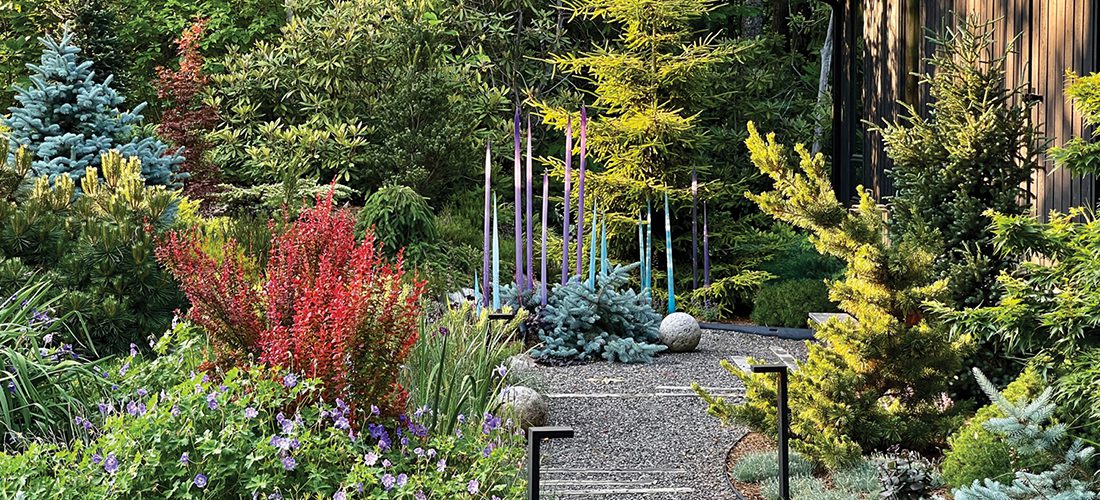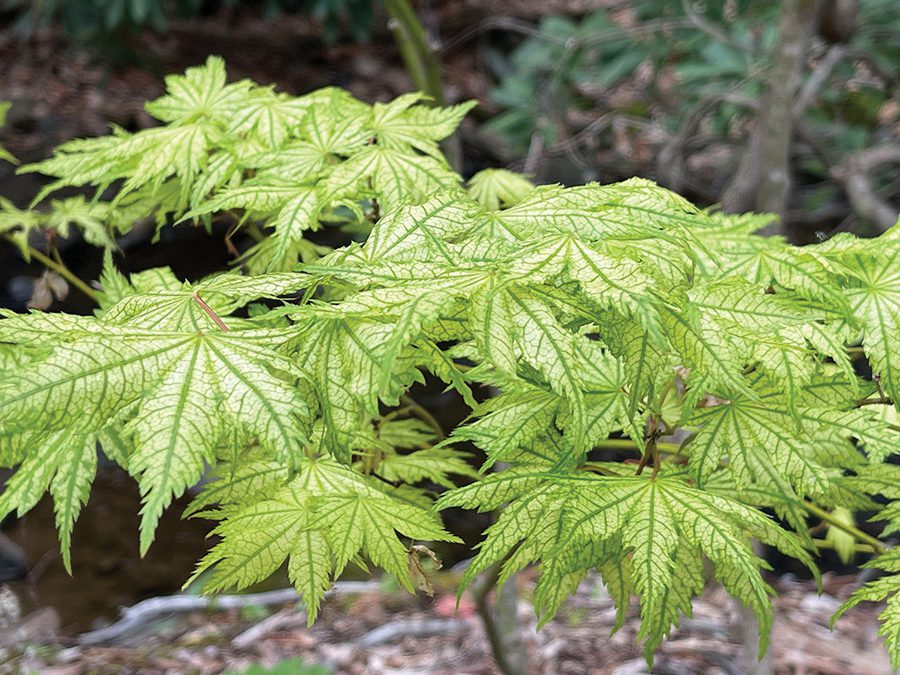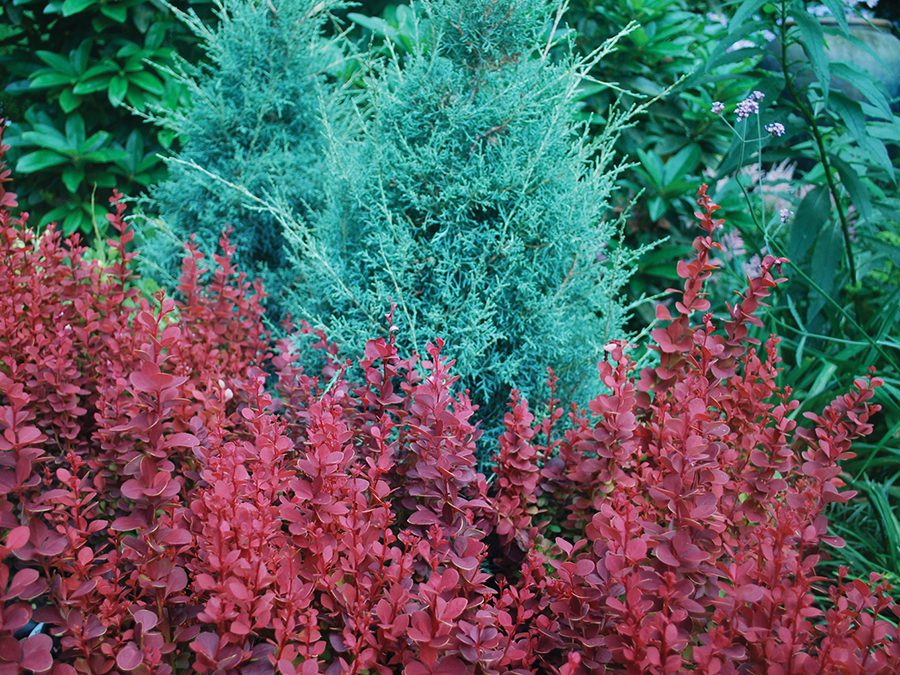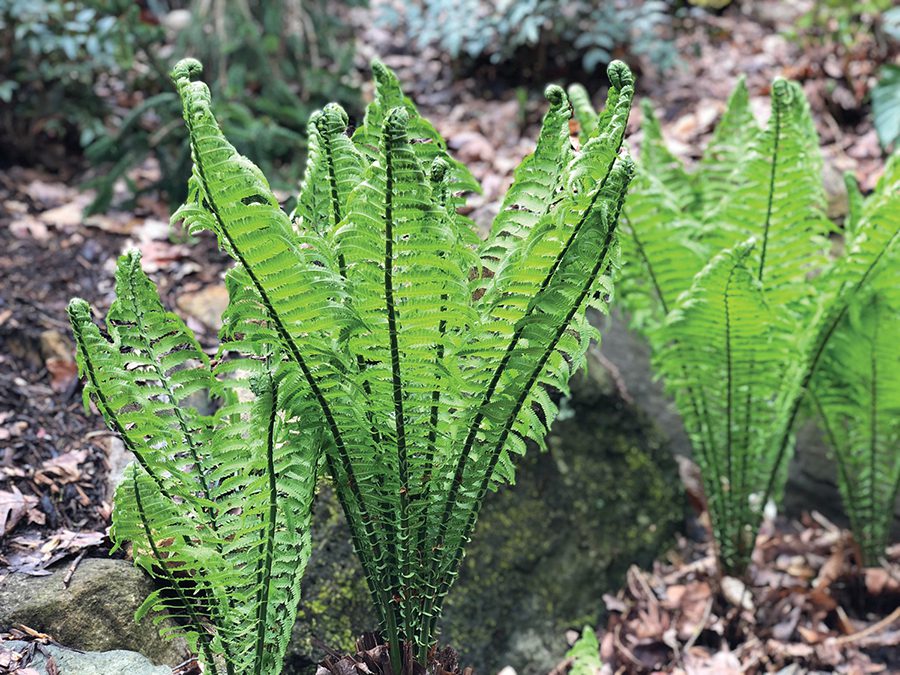Seeing green
November 30, 2023

What to plant for green foliage year-round
by Jay Sifford
Color is something we crave. It can be moody, cheerful, exhilarating or thought-provoking. Green, in its many shades, is I believe the most necessary color. It can be calming, permissive, optimistic, fresh — even envious. It speaks of nature, which is the best reason for incorporating it into our gardens. So many times, however, we default to “dark green.” Dark green is useful, but too much of it can be monotonous and uninspiring. In garden design, dark green gives the eye a place to rest between pops of color, and it recedes, making a small space feel larger. Additionally, dark green makes the perfect backdrop for most any color flower, especially red, its complementary color on the color wheel.
In winter, we crave green more than any other time of year. So how can we incorporate green in our gardens year-round and still keep it fresh and intentional? The answer lies in purposefully varying tints, shades and tones of green in order to create a unique garden space that speaks of your individuality all 12 months of the year.
Evergreens include hollies, conifers such as pines, and anything that holds its green foliage through the winter. These trees and shrubs take center stage during the colder months, then politely form a backdrop for flowering plants that take the stage during the warmer months. Year-round, they provide a structural backbone in the garden. Without that structure, a garden can appear haphazard and without interest, rather like someone scattered a mixture of seeds or raided the markdown rack at the big-box store.



Left: A weeping form of Norway spruce, along with the bluish-green foliage of ‘Firewitch’ dianthus, creates a vignette in the corner of this garden. Middle: ‘All Gold’ Shore Juniper creates a lively carpet that knits together a diverse collection of conifers. Right: The grass-like ‘Everillo’ Carex brightens up a shade garden.
Easily sourced evergreens in varying shades of green can add some spice to your year-round garden.
Employing lime green or chartreuse evergreens is a sure-fire way to breathe new life into a tired garden, especially when placed in front of dark green foliage. Low-growing conifers such as ‘All Gold’ shore juniper or ‘Limeglow’ horizontal juniper create a colorful and textural carpet. Such placement pulls the eye to a specific, desired place, and can knit together an eclectic collection of specimen plants. ‘Florida Sunshine’ illicium, a cultivar of a native shrub, can introduce the illusion of sunlight into a shady corner of the garden. ‘Sunshine’ Ligustrum sports the same hue but prospers in full sun rather than in the shade. My experience with this Ligustrum, however, shows that sections of the plant frequently revert to dark green as it matures. ‘Everillo’ Carex is a grass relative that sports year-round chartreuse foliage. It is approximately the same size and can be used in place of the over-planted liriope. All of these plants make a strong winter statement when days and gardens can become dreary.
Evergreens that lean toward bluish hues are extremely valuable in the landscape for a variety of reasons. Blue is the complementary color to orange on the color wheel. Why is this important? Many of our city’s homes are clad with brick that contains some degree of orange. Blue also politely livens up gray wooden cladding or stone walls. In gardens aglow with lively hues of red, orange and pink, blue serves the purpose of calming things down, thereby creating balance.
Useful evergreen conifers that sport bluish tones include the low-growing Blue Rug juniper, the larger Grey Owl juniper, deodar cedars ranging from the smaller ‘Prostrate Beauty’ and ‘Feelin’ Blue’ to the larger ‘Patti Faye,’ and various forms of the Blue Atlas Cedar. ‘Blue Zinger’ Carex repeats this color in grass-like form, as does the low-growing carpet-like perennial dianthus.



Left: Green-leafed Japanese maples can welcome spring with style. Middle: Bluish conifers complement orange in both garden plants and architecture. Bottom: Nothing says “spring” like emerging ostrich ferns.
Certain green conifers, such as many of the arborvitaes and some junipers, can take on a bronzy cast in winter. This shift in color, caused by low temperatures, can add seasonal color to the garden from unexpected sources.
Dark green conifers have been maligned as boring. Making informed choices in your planting scheme can emphasize texture and form, creating excitement rather than more of the expected in the arena of this hue. Consider plants such as Thunderhead black pine or weeping forms of Norway spruce. Don’t forget about some of the newer hollies such as ‘Acadiana’, ‘Robin’ and ‘Oakland’ that are adorned with red or orange berries during the colder months. These newer hollies hold their pyramidal shape better than the older ‘Nellie Stevens’ and require little to no pruning if sized appropriately for the space.
Finally, save some room for luscious tones of green for spring. Many of the green-leafed Japanese maples with reticulated or two-toned veined foliage announce spring in a dramatic way. Look for Japanese maples in the Ghost series, or ‘Peaches and Cream.’ Additionally, nothing says “spring” to me more than the unfurling new fronds of ostrich ferns.
Putting some of these plants to work in your garden will break the chains of boredom and the expected, and will turn your neighbors “green” with envy. SP
Jay Sifford is a Charlotte-based landscape designer who specializes in contemporary, Asian and transitional gardens. His work has been featured in Southern Living, Country Gardens and Fine Gardening, as well as Houzz and several books.
